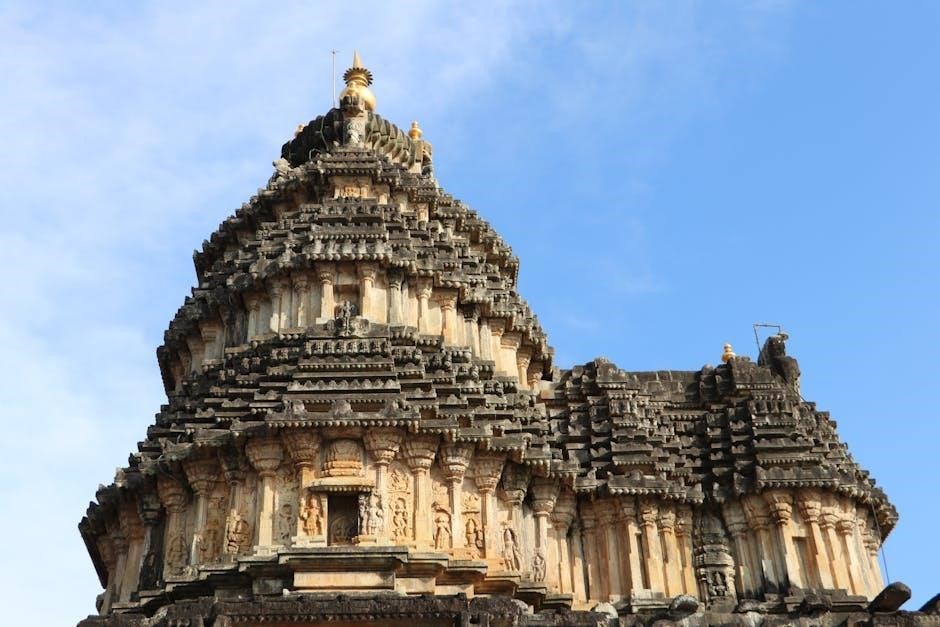Lalitha Sahasranama is a sacred Hindu hymn dedicated to Goddess Lalitha‚ an incarnation of Goddess Durga. It consists of 1000 divine names describing her attributes and glory‚ found in the Brahmanda Purana. This revered text is widely recited in devotion and is available in Kannada script for regional worshipers‚ enhancing its accessibility and spiritual significance.
1.1 Overview of Lalitha Sahasranama
Lalitha Sahasranama is a revered Hindu hymn comprising 1000 names of Goddess Lalitha‚ a divine form of Durga. It is part of the Brahmanda Purana and is considered a powerful devotional text. Each name in the Sahasranama highlights her divine attributes‚ spiritual significance‚ and cosmic role. The hymn is structured into 100 verses‚ with each verse containing 10 names‚ making it a comprehensive praise of the goddess. Its recitation is believed to bring spiritual enlightenment‚ peace‚ and fulfillment. The Kannada PDF version allows regional devotees to access and recite the hymn easily‚ preserving its cultural and religious heritage.
1.2 Historical Background of Lalitha Sahasranama
Lalitha Sahasranama originates from the Brahmanda Purana‚ an ancient Hindu scripture. It is believed to have been composed by Sage Agastya‚ a revered Vedic sage‚ who revealed the hymn to the world. The text has deep roots in Hindu spirituality‚ dating back thousands of years. Historically‚ it was recited in temples and during sacred rituals to invoke Goddess Lalitha’s blessings. Over time‚ its popularity grew‚ leading to translations into regional languages like Kannada‚ making it accessible to a broader audience. The Kannada version preserves the hymn’s spiritual essence while catering to linguistic preferences‚ ensuring its timeless relevance.

Significance of Lalitha Sahasranama
Lalitha Sahasranama holds profound spiritual and cultural significance‚ offering devotion‚ wisdom‚ and inner peace. Its Kannada PDF version enhances accessibility‚ preserving its sacred essence for modern worshipers globally.
2.1 Spiritual Importance of Lalitha Sahasranama
Lalitha Sahasranama is a sacred hymn embodying spiritual wisdom‚ comprising 1000 names of Goddess Lalitha. It is revered as a powerful tool for devotion‚ spiritual growth‚ and self-realization. The text‚ rooted in the Brahmanda Purana‚ is believed to grant divine blessings‚ peace‚ and liberation. Reciting it fosters a deep connection with the divine feminine‚ promoting mental clarity and emotional balance. Its Kannada PDF version ensures accessibility‚ allowing devotees to recite it with ease‚ making it an integral part of daily worship and spiritual practices for millions.
2.2 Cultural Impact of Lalitha Sahasranama
Lalitha Sahasranama has profoundly influenced Indian culture‚ particularly in South India‚ where it is deeply revered. Its verses are integral to rituals‚ festivals‚ and daily worship‚ fostering communal harmony. The hymn’s availability in Kannada PDF has furthered its reach‚ allowing regional devotees to connect with their cultural heritage. It has inspired literature‚ music‚ and art‚ embedding itself in the socio-religious fabric. This text symbolizes the enduring legacy of Hindu spirituality‚ bridging tradition and modernity through its accessible digital formats‚ ensuring its cultural relevance across generations.

Structure and Composition of Lalitha Sahasranama
Lalitha Sahasranama is a hymn comprising 1000 names of Goddess Lalitha‚ structured in poetic verses. Its composition in Kannada script enhances accessibility‚ elaborating on her divine attributes and power.
3;1 The Hymn’s Structure
Lalitha Sahasranama consists of 1000 names divided into sections‚ each highlighting Goddess Lalitha’s divine attributes. The hymn begins with a preamble‚ followed by the main body of names‚ and concludes with a Phalashruti. Structured in poetic verse‚ it uses couplets (slokas) to maintain rhythm and spiritual resonance. The Kannada PDF version retains this structure‚ making it accessible for devotees to recite and reflect on her divine qualities. This organized format ensures the hymn’s spiritual essence is preserved‚ aiding in devotion and meditation.
3.2 The 1000 Names of Goddess Lalitha Explained
The 1000 names of Goddess Lalitha are a profound expression of her divine attributes and cosmic role. Each name symbolizes her power‚ grace‚ and universal motherhood‚ such as “Shri Mata” (Mother of the Universe) and “Lalithambika” (Embodiment of Beauty). These names are not just a list but a spiritual journey‚ reflecting her nurturing and protective nature. The Kannada PDF version preserves this sacred enumeration‚ allowing devotees to connect deeply with her essence. The names are structured in poetic verse‚ making them accessible for recitation and contemplation‚ and are revered as a means to attain spiritual enlightenment and divine blessings.
3.3 The Phalashruti of Lalitha Sahasranama
The Phalashruti of Lalitha Sahasranama is a sacred concluding section that enumerates the spiritual benefits of reciting the hymn. It promises divine blessings‚ prosperity‚ and liberation for devotees who chant the 1000 names with devotion. The Phalashruti emphasizes that reciting Lalitha Sahasranama leads to spiritual growth‚ fulfillment of desires‚ and protection from life’s challenges. Available in Kannada PDF‚ this section is easily accessible to regional devotees‚ ensuring its teachings reach a wider audience and deepen their connection to Goddess Lalitha’s divine grace.
Benefits of Reciting Lalitha Sahasranama
Reciting Lalitha Sahasranama brings spiritual growth‚ divine protection‚ and liberation. It fosters mental peace‚ fulfills desires‚ and strengthens devotion‚ making it a powerful practice for seekers of enlightenment.
4.1 Spiritual Benefits of Recitation
Reciting Lalitha Sahasranama offers profound spiritual benefits‚ including enhanced devotion‚ inner peace‚ and a deeper connection with Goddess Lalitha. It aids in soul purification‚ grants divine grace‚ and accelerates spiritual growth. Many devotees believe it helps in overcoming negativity‚ fostering positivity‚ and achieving liberation. The hymn’s sacred vibrations are said to elevate consciousness‚ promoting self-realization and eternal bliss. Regular recitation is also believed to strengthen one’s spiritual foundation‚ making it a vital practice for those seeking enlightenment and divine harmony. Its impact is deeply transformative‚ guiding seekers toward a higher state of being and spiritual fulfillment.
4.2 Emotional and Mental Benefits
Reciting Lalitha Sahasranama brings emotional and mental equilibrium‚ reducing stress and anxiety. The rhythmic chanting soothes the mind‚ providing solace and emotional strength. It fosters resilience‚ helping devotees face life’s challenges with courage. The hymn’s divine energy promotes mental clarity and focus‚ enhancing decision-making skills. Regular recitation also cultivates gratitude and positivity‚ uplifting one’s emotional state. By calming the mind and heart‚ it offers a sense of inner stability‚ helping individuals navigate life’s difficulties with grace and poise. This practice is a powerful tool for emotional healing and mental well-being.
4.3 Practical Benefits in Daily Life
Reciting Lalitha Sahasranama offers numerous practical benefits‚ enhancing daily life by fostering positivity and equilibrium. It improves focus‚ enabling better concentration in work and personal tasks. The hymn’s vibrations create a harmonious environment‚ reducing conflicts and fostering better relationships. Regular recitation boosts self-confidence‚ helping individuals tackle challenges effectively. Additionally‚ it promotes emotional resilience‚ aiding in overcoming obstacles with grace. The structured chanting also enhances mental clarity‚ supporting better decision-making. By integrating this practice into daily routines‚ one can experience improved overall well-being‚ leading to a more balanced and fulfilling life.

Lalitha Sahasranama PDF in Kannada
The Lalitha Sahasranama PDF in Kannada offers regional devotees easy access to the sacred hymn. It features the Kannada script‚ making it accessible for those familiar with the language. Available on platforms like Vaidika Vignanam and Scribd‚ these PDFs are often free or cost-effective‚ ensuring widespread reach. They also include traditional and simplified script options‚ catering to diverse reader preferences while preserving the text’s spiritual essence.
5.1 Why Choose a Kannada Lalitha Sahasranama PDF?
Choosing a Kannada Lalitha Sahasranama PDF is ideal for devotees fluent in Kannada‚ as it enhances their spiritual experience by allowing them to recite the hymn in their native language. This accessibility ensures deeper emotional and spiritual connection. Additionally‚ Kannada script PDFs cater to regional preferences‚ making the sacred text more relatable and easier to understand. Many PDFs offer both traditional and simplified script options‚ accommodating diverse reader needs. Furthermore‚ these documents are widely available on platforms like Vaidika Vignanam and Scribd‚ ensuring easy access for devotees seeking to deepen their spiritual practices through this revered hymn.
5.2 Features of a Good Lalitha Sahasranama PDF
A good Kannada Lalitha Sahasranama PDF should include clear‚ legible text in both traditional and simplified Kannada scripts‚ ensuring readability for all users. Proper formatting with accurate anusvaras and diacritical marks is essential‚ preserving the hymn’s authenticity and pronunciation. Additional features like an introduction‚ phalashruti‚ and section breaks enhance understanding. Many PDFs include English translations or explanations for deeper comprehension. High-quality digital resolution ensures the text remains clear on all devices‚ while ease of navigation and downloadable options make it user-friendly. These features collectively enrich the spiritual experience for devotees.
5.3 How to Download Lalitha Sahasranama PDF in Kannada
To download the Lalitha Sahasranama PDF in Kannada‚ visit reputable spiritual websites like Vaidika Vignanam or Scribd. Search for “Lalitha Sahasranama Kannada PDF” on the platform. Verify the source for authenticity and check reviews or descriptions to ensure it includes phalashruti and proper formatting. Click the download link‚ following any on-screen instructions. Some sites may require free registration. Ensure your device has sufficient storage and a stable internet connection for a smooth download. This allows devotees to access the sacred text conveniently for daily recitation and worship.

Cultural and Religious Impact of Lalitha Sahasranama
Lalitha Sahasranama deeply influences South Indian rituals‚ festivals‚ and daily worship‚ reflecting cultural identity and spiritual devotion. It enriches Kannada literature while embodying divine values and traditions‚ inspiring worshippers globally.
6.1 Role in Hindu Rituals and Festivals
Lalitha Sahasranama holds a prominent role in Hindu rituals and festivals‚ particularly in South India. It is often recited during Navaratri celebrations and Durga Puja‚ invoking Goddess Lalitha’s divine energy. The hymn is integral to temple worship‚ homas‚ and sacred ceremonies‚ fostering spiritual connection. Its recitation is believed to bring prosperity and protection‚ making it a cornerstone of devotional practices. The Kannada PDF version enhances accessibility‚ allowing devotees to easily incorporate this sacred text into their rituals and daily worship‚ strengthening cultural and spiritual heritage.
6.2 Influence on Kannada Literature and Language
Lalitha Sahasranama has profoundly influenced Kannada literature‚ inspiring poets and scholars to explore its spiritual and philosophical depth. Its verses‚ rich in devotion and symbolism‚ have been a source of inspiration for literary works. The Kannada script’s traditional and simplified forms are preserved through its recitation and study. The text’s linguistic beauty and cultural significance have enriched Kannada language‚ making it a cornerstone of regional identity. The availability of Lalitha Sahasranama in Kannada PDF further promotes its study‚ ensuring its influence endures in both literature and daily life‚ fostering a deeper connection to heritage.
6.3 Lalitha Sahasranama in Daily Worship Practices
Lalitha Sahasranama holds a central place in daily worship‚ particularly in South India. Devotees recite it during rituals‚ pujas‚ and personal meditation to seek divine blessings. Many incorporate it into their morning and evening prayers‚ believing it brings spiritual growth and peace. The Kannada PDF version makes it accessible for regional devotees to recite with ease. Regular recitation is thought to purify the mind‚ strengthen faith‚ and foster a deeper connection with the divine; It is also chanted in group gatherings‚ fostering communal spirituality and unity among worshipers‚ making it a vital part of daily devotional practices.

Related Texts and Scriptures
Lalitha Sahasranama is complemented by the Soundarya Lahari‚ which praises Goddess Lalitha’s beauty and divine energy. Other Sahasranamas‚ like Vishnu Sahasranama‚ share similar reverence. It connects to the Rig Veda‚ reflecting Vedic traditions.
7.1 Soundarya Lahari and Its Connection
The Soundarya Lahari is a revered devotional poem composed by Adi Shankaracharya‚ consisting of 103 shlokas. It glorifies Goddess Lalitha‚ describing her divine beauty and cosmic power. This text is deeply connected to the Lalitha Sahasranama‚ as both extol the goddess’s attributes. The first 41 verses of Soundarya Lahari are said to be in Sanskrit‚ while the remaining are in Tamil‚ reflecting its linguistic and cultural richness. Together‚ these works form a comprehensive spiritual framework‚ often recited alongside the Sahasranama in worship. Their connection highlights the goddess’s role in transcendent beauty and divine energy.
7.2 Other Sahasranamas and Their Significance
Besides the Lalitha Sahasranama‚ Hindu scripture includes numerous Sahasranamas dedicated to other deities‚ such as Vishnu Sahasranama and Shiva Sahasranama. Each highlights the unique attributes and divine qualities of its deity‚ serving as a medium for devotion and spiritual growth. These texts are often recited in rituals and daily worship‚ offering blessings and introspection. Their significance lies in their ability to connect devotees with the divine‚ fostering a deeper understanding of cosmic energies and divine grace. Like Lalitha Sahasranama‚ these Sahasranamas are also available in Kannada‚ ensuring accessibility for regional devotees.
7.3 The Connection to the Rig Veda and Other Vedas
Lalitha Sahasranama draws its spiritual essence from the Vedas‚ particularly the Rig Veda‚ which is the oldest and most sacred Vedic text. The hymn’s structure and the divine attributes of Goddess Lalitha resonate with Vedic concepts of cosmic order and divine energy. Similar themes of devotion and worship are reflected in other Vedas‚ such as the Yajur and Sama Vedas‚ which emphasize the connection between human and divine realms. This Vedic heritage enriches Lalitha Sahasranama‚ making it a profound spiritual resource accessible in Kannada for devotees seeking deeper understanding and worship.

Digital Platforms for Lalitha Sahasranama PDF
Popular platforms like Vaidika Vignanam and Scribd offer downloadable Lalitha Sahasranama PDFs in Kannada‚ ensuring easy access for devotees seeking spiritual enrichment through digital convenience.
8.1 Popular Websites for Downloading Lalitha Sahasranama PDF
Several reputable websites offer free downloads of the Lalitha Sahasranama PDF in Kannada‚ catering to devotees seeking convenience. Platforms like Vaidika Vignanam and Austin Hindu Temple provide authentic versions‚ ensuring spiritual authenticity. Bhaskara Prakasha Ashram also offers downloadable PDFs‚ enriched with proper anusvaras for accurate recitation. These websites are trusted for their adherence to traditional scripts and simplified formats‚ making the sacred text accessible to a wide audience. They serve as invaluable resources for those who prefer digital access to this revered hymn.
8.2 Scribd and Other Document-Sharing Platforms
Scribd‚ a leading document-sharing platform‚ hosts numerous PDF versions of Lalitha Sahasranama in Kannada‚ uploaded by users. While some documents may require a subscription‚ many are freely accessible. Other platforms like Google Drive and Telegram channels also serve as repositories for these PDFs‚ shared by devotees and spiritual groups. These platforms provide easy access to the text‚ enabling widespread dissemination and fostering a sense of community among followers. They remain vital resources for those seeking digital versions of this sacred hymn in Kannada.
8.3 Vaidika Vignanam and Similar Resources
Vaidika Vignanam is a prominent online repository offering spiritual texts‚ including the Lalitha Sahasranama in Kannada. This platform provides meticulously formatted PDFs‚ ensuring clarity and readability. Similar resources like Vedic libraries and dedicated Hindu scriptural websites also host these documents‚ often with annotations and transliterations. These platforms cater to both devotees and scholars‚ preserving ancient texts while making them accessible for modern digital audiences. Their efforts ensure the enduring availability of Lalitha Sahasranama for spiritual and educational purposes.

Language and Script in Lalitha Sahasranama PDF
The Lalitha Sahasranama PDF in Kannada uses the traditional Kannada script‚ preserving its cultural essence. Simplified anusvaras enhance readability‚ ensuring devotees can recite the hymn accurately and meaningfully.
9.1 The Importance of Kannada Script
The Kannada script holds immense cultural and spiritual significance in the Lalitha Sahasranama PDF. It preserves the traditional essence of the hymn‚ connecting devotees to their linguistic heritage. The script’s intricate design aligns with the divine nature of the text‚ enhancing the spiritual experience during recitation. For Kannada-speaking devotees‚ reading the Sahasranama in their native script fosters a deeper emotional and spiritual connection. Additionally‚ the script’s clarity ensures accurate pronunciation and comprehension‚ making it a vital part of devotion and worship in Karnataka and among Kannada-speaking communities worldwide.
9.2 Simplified Kannada vs. Traditional Script
The debate between simplified Kannada and traditional script in Lalitha Sahasranama PDFs revolves around readability and cultural preservation. Simplified Kannada uses basic characters‚ making it easier for modern readers‚ especially the younger generation‚ to understand and recite the hymn. Meanwhile‚ the traditional script‚ with its intricate anusvaras and complex letterforms‚ is cherished for its sacredness and historical significance. Both versions coexist‚ catering to different preferences—simplified for accessibility and traditional for preserving heritage. This duality ensures the text remains relevant while honoring its ancient roots.
9.3 The Role of Anusvaras in the Text
Anusvaras play a vital role in the accurate pronunciation and spiritual efficacy of Lalitha Sahasranama. These nasal sounds‚ represented by the symbol “ं‚” are crucial for maintaining the sanctity of the text. In Kannada PDF versions‚ anusvaras are often highlighted to ensure proper recitation‚ as their omission can alter the meaning and spiritual impact. Traditional scripts emphasize anusvaras for authenticity‚ while simplified versions may reduce their complexity. This balance ensures the text remains accessible while preserving its sacredness‚ making it easier for devotees to recite correctly and derive spiritual benefits.

Lalitha Sahasranama and Its Verses
Lalitha Sahasranama’s verses are profound‚ with each name revealing Goddess Lalitha’s divine attributes. The Kannada PDF presents these verses in a clear‚ readable script‚ enhancing devotion and understanding for followers.
10.1 Key Verses and Their Meanings
The Lalitha Sahasranama contains key verses that highlight Goddess Lalitha’s essence. The first verse‚ Sri Mata‚ signifies her role as the divine mother‚ while the final verse‚ Sri Lalitambikai Namah‚ is a dedication to her universal form. These verses‚ available in the Kannada PDF‚ provide deep spiritual insights‚ emphasizing her qualities as the embodiment of cosmic energy and the source of creation‚ preservation‚ and destruction. Each name in the Sahasranama is a meditation on her divine attributes‚ fostering devotion and inner peace among devotees.
10.2 The Significance of the First and Last Verses
The first verse of Lalitha Sahasranama‚ Sri Mata‚ introduces Goddess Lalitha as the universal mother‚ embodying cosmic energy and divine love. The last verse‚ Sri Lalitambikai Namah‚ concludes the hymn by invoking her blessings and eternal presence. Both verses‚ available in the Kannada PDF‚ encapsulate her role as the supreme deity‚ governing creation‚ preservation‚ and destruction. These verses are deeply revered‚ symbolizing the beginning and culmination of devotion‚ and are often chanted for spiritual enlightenment and inner peace‚ reflecting her omnipresent and nurturing nature.
10.3 The Mantra’s Connection to Chakras and Energy
Lalitha Sahasranama is deeply linked to the activation and balance of chakras‚ particularly the Sahasrara (crown) and Anahata (heart) chakras. The mantra’s vibrations resonate with divine energy‚ harmonizing the body and mind. Each name in the Sahasranama is believed to awaken specific energy centers‚ fostering spiritual growth and inner peace. Available in Kannada PDF‚ this sacred text guides practitioners to channel energy effectively‚ enhancing meditation and worship. The recitation is said to align one’s consciousness with cosmic forces‚ facilitating a deeper connection to Goddess Lalitha and her transformative power.

Lalitha Sahasranama in Practice
Lalitha Sahasranama is integral to daily worship‚ offering spiritual growth and peace. Its recitation in Kannada PDF enhances accessibility‚ making it easier for devotees to practice rituals and meditation effectively.
11.1 How to Recite Lalitha Sahasranama Correctly
To recite Lalitha Sahasranama correctly‚ begin with a peaceful mind and proper posture. Choose a quiet‚ sacred space for recitation. Start with preliminary mantras like Om Aim Hreem Shreem and invoke Goddess Lalitha. Use a Kannada PDF for accurate pronunciation and clarity. Recite each name slowly‚ understanding its meaning. Maintain concentration and avoid distractions. Complete the recitation with closing prayers to seek blessings. Regular practice enhances spiritual benefits and connects devotees deeply with the divine energy of Goddess Lalitha.
11.2 The Role of Meditation in Recitation
Meditation plays a crucial role in Lalitha Sahasranama recitation‚ deepening its spiritual impact. Before reciting‚ focus on breathing to calm the mind. Visualize Goddess Lalitha‚ imagining her divine form and attributes. As you recite each name‚ reflect on its meaning‚ allowing devotion to flow naturally. Pause between verses to maintain focus and connection. Regular meditation during recitation enhances mental clarity‚ emotional balance‚ and spiritual growth. This practice strengthens the bond with the divine‚ fostering inner peace and harmony in daily life through the sacred verses of Lalitha Sahasranama.
11.3 Using the PDF for Group Chanting and Satsangs
The Lalitha Sahasranama PDF in Kannada is an excellent resource for group chanting and satsangs‚ fostering unity and devotion among participants. Its clear formatting ensures synchronized recitation‚ while the digital format makes it easily shareable across devices. Many communities use it to lead collective worship‚ enhancing spiritual energy and creating a harmonious atmosphere. The PDF’s accessibility allows everyone to follow along effortlessly‚ making it a valuable tool for organized religious gatherings and fostering a sense of togetherness in devotion to Goddess Lalitha.


